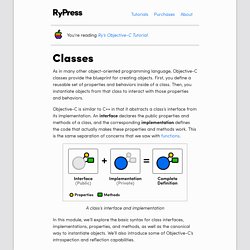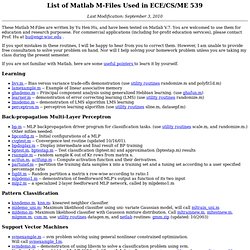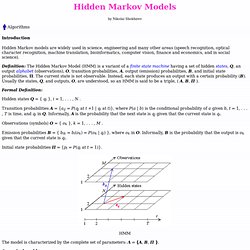

Classes - Ry’s Objective-C Tutorial - RyPress. As in many other object-oriented programming language, Objective-C classes provide the blueprint for creating objects.

First, you define a reusable set of properties and behaviors inside of a class. Then, you instantiate objects from that class to interact with those properties and behaviors. Objective-C is similar to C++ in that it abstracts a class’s interface from its implementation. An interface declares the public properties and methods of a class, and the corresponding implementation defines the code that actually makes these properties and methods work. This is the same separation of concerns that we saw with functions. In this module, we’ll explore the basic syntax for class interfaces, implementations, properties, and methods, as well as the canonical way to instantiate objects. Creating Classes We’ll be working with a class called Car whose interface resides in a file named Car.h (also called a “header”) and whose implementation resides in Car.m. Interfaces Implementations Summary.
Weka 3 - Data Mining with Open Source Machine Learning Software in Java. Weka is a collection of machine learning algorithms for data mining tasks. It contains tools for data preparation, classification, regression, clustering, association rules mining, and visualization. Found only on the islands of New Zealand, the Weka is a flightless bird with an inquisitive nature. The name is pronounced like this, and the bird sounds like this. Weka is open source software issued under the GNU General Public License. We have put together several free online courses that teach machine learning and data mining using Weka. Weka supports deep learning! Matlab mfiles used in ECE/CS/ME 539. Last Modification: September 3, 2010 These Matlab M-Files are written by Yu Hen Hu, and have been tested on Matlab V.7.

You are welcomed to use them for education and research purposese. For commercial applications (including for-profit education services), please contact Prof. Hu at hu@engr.wisc.edu . If you spot mistakes in these routines, I will be happy to hear from you to correct them. If you are not familiar with Matlab, here are some useful pointers to learn it by yourself. Learning bvv.m -- Bias versus variance trade-offs demonstration (use utility routines randomize.m and polyfit1d.m) lamexample.m -- Example of linear associative memory ghademo.m -- Principal component analysis using generalized Hebbian learning. Back-propagation Multi-Layer Perceptron bp.m -- MLP backpropagation driver program for classification tasks. Pattern Classification Support Vector Machines svmexample.m -- svm problem solving using general nonlinear constrained optimization.
Clustering Radial Basis Network. Algorithms - Hidden Markov models. By Nikolai Shokhirev Introduction Hidden Markov models are widely used in science, engineering and many other areas (speech recognition, optical character recognition, machine translation, bioinformatics, computer vision, finance and economics, and in social science).

Definition: The Hidden Markov Model (HMM) is a variant of a finite state machine having a set of hidden states, Q, an output alphabet(observations), O, transition probabilities, A, output (emission) probabilities, B, and initial state probabilities, Π. The current state is not observable. Instead, each state produces an output with a certain probability (B).
Formal Definition: Hidden states Q = { qi }, i = 1, . . . , N . Transition probabilities A = {aij = P(qj at t +1 | qi at t)}, where P(a | b) is the conditional probability of a given b, t = 1, . . . , T is time, and qi in Q. Observations (symbols) O = { ok }, k = 1, . . . , M . Emission probabilities B = { bik = bi(ok) = P(ok | qi) }, where ok in O. Recursion: Main/Time Passes Montage. Weka 3 - Data Mining with Open Source Machine Learning Software in Java. Matlab mfiles used in ECE/CS/ME 539. Software by Kevin Murphy and students. Machine learning in Python — scikit-learn 0.11 documentation.